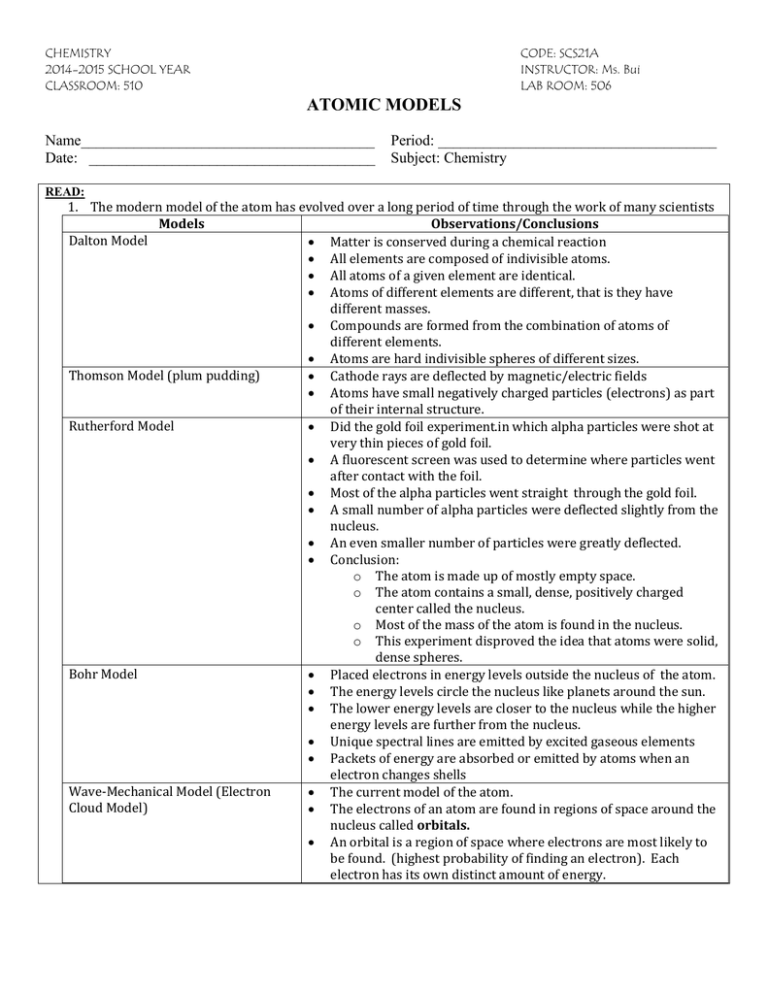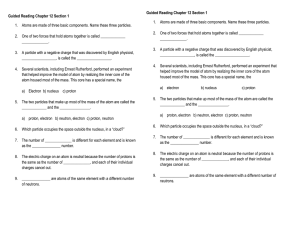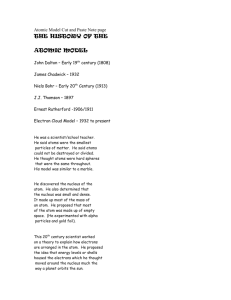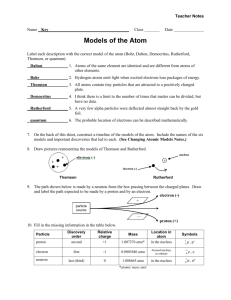Document
advertisement

CHEMISTRY 2014-2015 SCHOOL YEAR CLASSROOM: 510 CODE: SCS21A INSTRUCTOR: Ms. Bui LAB ROOM: 506 ATOMIC MODELS Name_______________________________________ Date: ______________________________________ Period: _____________________________________ Subject: Chemistry READ: 1. The modern model of the atom has evolved over a long period of time through the work of many scientists Models Observations/Conclusions Dalton Model Matter is conserved during a chemical reaction All elements are composed of indivisible atoms. All atoms of a given element are identical. Atoms of different elements are different, that is they have different masses. Compounds are formed from the combination of atoms of different elements. Atoms are hard indivisible spheres of different sizes. Thomson Model (plum pudding) Cathode rays are deflected by magnetic/electric fields Atoms have small negatively charged particles (electrons) as part of their internal structure. Rutherford Model Did the gold foil experiment.in which alpha particles were shot at very thin pieces of gold foil. A fluorescent screen was used to determine where particles went after contact with the foil. Most of the alpha particles went straight through the gold foil. A small number of alpha particles were deflected slightly from the nucleus. An even smaller number of particles were greatly deflected. Conclusion: o The atom is made up of mostly empty space. o The atom contains a small, dense, positively charged center called the nucleus. o Most of the mass of the atom is found in the nucleus. o This experiment disproved the idea that atoms were solid, dense spheres. Bohr Model Placed electrons in energy levels outside the nucleus of the atom. The energy levels circle the nucleus like planets around the sun. The lower energy levels are closer to the nucleus while the higher energy levels are further from the nucleus. Unique spectral lines are emitted by excited gaseous elements Packets of energy are absorbed or emitted by atoms when an electron changes shells Wave-Mechanical Model (Electron The current model of the atom. Cloud Model) The electrons of an atom are found in regions of space around the nucleus called orbitals. An orbital is a region of space where electrons are most likely to be found. (highest probability of finding an electron). Each electron has its own distinct amount of energy. Name_______________________________________ Date: ______________________________________ Period: _____________________________________ Subject: Chemistry 1. An orbital is a region of space where there is a high probability of finding a. A proton b. A positron c. A neutron d. An electron 2. In the late 1800s, experiments using cathode ray tube led to the discovery of the a. Electron b. Neutron c. Positron d. Proton 3. According to the wave-mechanical model of the model, an orbital is a region of the most probable location of a. An alpha particle b. A gamma ray c. An electron d. A proton 4. In the wave-mechanical model of the atom, an orbital is defined as a. A region of the most probable proton location b. A region of the most probable electron location c. A circular path traveled by a proton around the nucleus d. A circular path traveled by an electron around the nucleus 5. The gold foil experiment led to the conclusion that each atom in the foil was composed mostly of empty space because most alpha particles directed at the foil a. Passed through the foil b. Remained trapped in the foil c. Were deflected by the nuclei in gold atoms d. Were deflected by the electrons in gold atoms 6. An orbital is defined as a region of the most probable location of a. An electron b. A neutron c. A nucleus d. A proton Ms. Bui’s Chemistry Class 2







